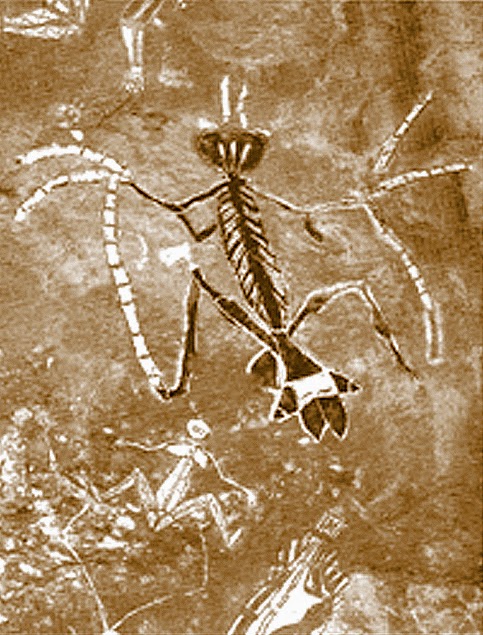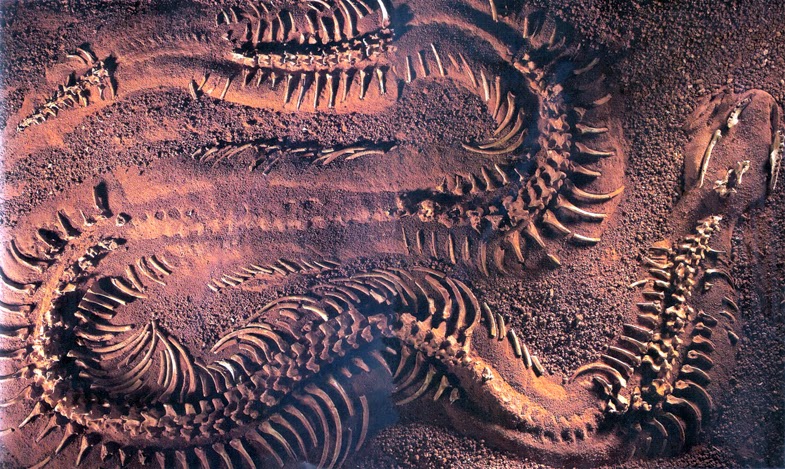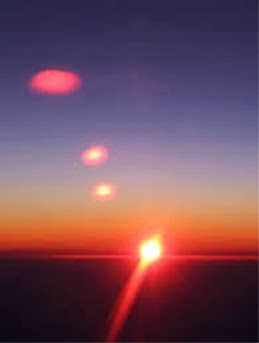“And the sun sank again on the grand
Australian bush – the nurse and tutor of eccentric minds, the home of the
weird, and of much that is different from things in other lands.”
-Henry Lawson, “The
Bush Undertaker”, 1896
Australia has three major connexions with
the Cthulhu Mythos and the works of H. P. Lovecraft: it is the location of the
City of the Great Race (“The Shadow Out
Of Time”, 1936); it has strong inferential connexions to the Dreamlands;
and it is the location of an idol of the Great Old One, Cthulhu, taken from
R’lyeh in 1925 by the crew of the SS
Alert (“The Call Of Cthulhu”,
1928). Furthermore it is the gateway to Antarctica and the Elder Thing cities
hidden there (“At The Mountains Of
Madness”, 1936). The country is also host to a large community of Chinese
immigrants and China is the land where the leaders of the worldwide Cthulhu Cult reside (according to the
evidence gained from the cultist ‘Castro’ by Inspector Legrasse in “The Call of Cthulhu”). Australia is
also the gateway to the South Seas for many Westerners, to Easter Island, to
Ponape and the Andaman Islands - places where the Mythos has an ancient grip
(as revealed in the Ponape Scriptures,
translated by Exekiel Hoag).
Throughout the ‘20s and ‘30s Sydney was
the home to many Theosophist cults: Golden
Dawn recruit Annie Besant stayed there and, along with Bishop Leadbeater,
established the Order of the Star of the
East, along with local entrepreneurs Thomas Bakewell and Giordano Bruno.
Walter and Marion Burley Griffin, both Theosophist acolytes, came to Australia
to design Canberra, the nation’s capital, and stayed to form a schism sect from
a base in their residential Castlecrag estate in Sydney, creating an antipodean
home for the study of Anthroposophy.
Given these connexions to the
Unspeakable, we should take the most likely inroads for horror narratives one
by one. They are as follows:
The
Dreamlands
The indigenous peoples of Australia have
a belief system based on something which they refer to as the ‘Dreaming’. This
is a slippery notion, in that the term encompasses a wide range of meanings
depending upon its use. In one sense, it means a body of myths and legends
associated with a local tribe or language group; in another sense, it refers to
a system of laws and regulations which control the conduct of the local people;
in yet another sense, it simply means a time long ago, before living memory. An
individual tribe has a ‘Dreaming’ in the sense that the community has a history
which can be related by the elders of the tribe and which promotes a sense of
communal identity; as well, an individual has their own ‘Dreaming’, which
refers to their own experiences, especially the course of their spiritual
development. The term also has a connexion to the subconscious and the
night-time images perceived during sleep, experiences which are equated with
journeys of the soul and encounters with magical creatures and events. This is
where we come closest to Lovecraft’s notion of Dreaming as an escape from
Earthly environments.
A major plank of the “Dreamlands Theory”
(if such a term can be coined) is that the Dreamlands of one planet are
significantly different from that of another. Thus the Dreamlands of Cykranosh
(Saturn) are quite unlike Earth’s Dreamlands. The Dreaming Skill, which allows such adepts as Randolph Carter to
re-organise the Dream landscape to suit their own purposes, argues that
cultural differences have as much a part to play in the way that the Dreamlands
are constructed as anything else. With this in mind, we can start to look at
the way the Australian Aborigines might have created their Dreaming, as an
adjunct to their own spiritual lives.
In the short story “Through the Gate of the Silver Key”, Lovecraft and E. Hoffman
Price talk about a mysterious cavern entrance surmounted by the sculpted image
of a white hand; the indigenous Australians are not known as a culture which
works stone but they have plenty of cavern entrances marked with the painted
image of a white hand, usually daubed with white ochre (such as in the image
above). Through a Mythos lens, this could easily be seen as their way of
marking those locales where penetration through to the Dreamlands is possible
for those with the knowledge or skill to do so.
Without resorting to a complete
re-writing of the gaming material already available to outline the Dreamlands
and its occupants, it is easy to postulate that the Aboriginal Dreaming lands
lie some distance from the map familiar to most explorers of Earth’s
Dreamlands. After all, following Lovecraft’s literary line of placing
unknowable peoples, things and places ‘over there’ in locations unmapped and
inaccessible (e.g., Kadath or China), these dreamlands could well be simply an
unexplored, inaccessible region, say, to the west of those Dreamlands countries
and kingdoms of which we are most familiar.
With this rationale, it becomes possible
to reinterpret certain beings of the Dreamlands through the mythology of the
Aboriginal people. The strange, vampiric Yara-ma-yha-who, for example, starts
to look somewhat like a Haemophore; Tjinimin, the bat-creature who stole fire
from the earth in certain tales, could possibly be an incarnation of
Nyarlathotep, especially given his ‘Father of all Bats’ avatar; the Rainbow
Serpent could possibly have been a dhole. Is Purelko, the afterlife of certain
tribes of the Arnhem Land region, a place within the Dreamlands? Are the
night-dwelling Nadubi some species of Glaaki-worshipping creature capable of
using their god’s spines to steal away the lives of others? Are the Mimi a race
of advanced Dreamlands beings who abandoned the Earth millennia ago? There are
all sorts of possibilities...
The
Great Race of Yith
The distant north-western deserts of the
Australian Outback are the location of the city called Pnakotus, occupied by
the great Race of Yith upon their arrival on Earth four-hundred million years
ago. The exact whereabouts of this city were lost, unrecorded, until the
Peaslee Expedition of 1934, which undertook the first mapping and excavations
there.
The Yithians occupied the bodies of tall,
cone-like creatures which their searching minds discovered already dwelling on
Earth. It is largely speculative as to whether these creatures were originally
sentient and intelligent, as the Yithian mind transfer is designed to displace
the resident intellect and make room for the invading mind. It is known that
the Yithians moved on from these forms to occupy the bodies of a beetle race on
another world, leaving their massive cone bodies to die off in a mass
extinction in the desert sands. Who knows what fate befell the original minds
of these mortal husks?
Long-time players of Call of Cthulhu may have come across the campaign series “Masks of Nyarlathotep”; if so, then the
antipodean material provided therein is an excellent (although, in several
places, inaccurate) rendering of uncanny events in Australia’s north west and
could be used in conjunction with the material given here to stage an extended
adventure.
The
Worldwide Cthulhu Cult
In March of 1925, the stars were almost
right: R’lyeh the corpse city rose from the depths of the sea and Great
Cthulhu’s slumber was temporarily interrupted. A crew of sailors aboard the SS Alert made their way onto the island
and became lost in the corpse city: only two of them made it back to the ship;
only one of them returned – however briefly – to civilisation.
On the ship, which made its way, battered
and torn, back to Sydney Harbour, was an idol to the Sleeping God. It was taken
from the ship and placed within the collections of the Australian Museum where
it remains to this day, accompanied by a speculative description as to its
cultural origin and the material of its construction, both of which defy
analysis. It was on display to the public until a frenzied would-be thief
attempted to smash his way into the case and abscond with it; nowadays it
resides, tucked away, in the Museum archives.
The issue with this piece of artistic
impedimenta is not so much the discernment of what it stands for, but rather,
the understanding of what it means to others. The faithful who would worship
before this unholy image, or mercenary types who would claim it in order to
sell it back to the faithful, are legion, and it is supposed that the defences which
keep it locked within Australia’s first museum are wholly insufficient to the
task of its maintenance.
The
Tcho-tcho Menace
The original, suppressed, version of
Kelly’s cartoon from “The Bulletin”
Wherever there has been a discovery of
gold and a subsequent rush to unearth it, so to there has been an inrushing of
Chinese nationals to join in the spoils. The Chinese term for Canada for
instance, translates as “Golden Mountain” and many Chinese journeyed there in
search of wealth, many never to return. No less eager were those Chinese who
rushed to Australia (the “New Golden Mountain”) when the discovery of gold was
announced in New South Wales and Victoria in 1851; and lurking amongst their
numbers, like rats accompanying a steam-ship’s travels, were the insidious
Tcho-tcho.
These degenerate meddlers are known to
sink down solid roots amid the organised crime of whatever culture in which
they find themselves. Further, they have a track record of infiltrating secret
communities, and Australia, in the first half of the Twentieth Century, was
awash with exclusive cabals, from the Communist Leagues to the fascist New
Guard and every permutation of political and mystical flavour in between. This
was ripe terrain for the Tcho-tcho; something they could really get their nasty,
pointy little teeth into.
As well, reading from Guy Boothby’s Dr
Nikola novels (A Bid for Fortune etc.),
certain mystical regalia from Chinese secret organisations were smuggled into
Australia during the late 1800s and various powerful agents – including Dr
Nikola himself - were sent to retrieve them. Can we not see the hidden hand of
the Tcho-tcho in these incidents?
Metaphysical
Research: Spiritualists, Theosophists and other philosophies
Interest in Spiritualism was widespread
throughout the English-speaking world from the late Victorian era all the way
through to the Second World War. No less than any other country at this time,
Australia was also caught up in the fascination. On top of this, the country
was also visited by the two great contemporary speakers on the subject – both
for and against – Harry Houdini and Sir Arthur Conan Doyle. As well, Madame
Blavatsky’s Secret Doctrine and its
sequel Isis Unveiled were making
inroads into the spiritual landscape of the nation, supported by such outspoken
proponents as Arthur Deakin, Walter and Marion Burley-Griffin, and Annie
Besant. Theosophical communities took root and still exist today, along with
the offshoot faith Anthroposophy, developed by Rudolf Steiner during his stay
in the country.
The Burley-Griffins designed the new
capital city Canberra to be a mystical generator of spiritual energies, an
effort which fell short of the mark through political in-fighting and economic
reticence; the Sydney Theosophists built a huge auditorium on the waterfront
near Kurnell from which to view the impending Apocalypse (which didn’t come
about due, no doubt, to some last-minute, behind-the-scenes intervention); and
witchcraft had taken root in the Botany Bay colony from the earliest times: how
else do you explain all of those staked corpses that were unearthed at the
crossroads of Bridge and George Streets during the re-development of the Rocks?
Other
Stuff Mankind Was Not Meant to Know About
In the 20s and 30s Australia was still largely
a place unknown: the environment was treacherous and deadly; the landscape was as
inimical to human life as the creatures that thrived within its ranges. The
indigenes that seemed capable of inhabiting the Bush were so far removed from
the Invader’s concept of civilisation that they may well have been alien creatures.
Add to this that the “civilised” coastal fringes of the country were rapidly
filling up with races, cultures and creeds so multifarious and disparate, that,
beneath an eggshell-thin facade of social conformity, wild and strange chaos
was brewing.
The bringing of “Kanakas” to the
canefields of Queensland brought an influx of resentment and revenge: what
strange island magicks might it also have brought to enact that vengeance? Wild
Afghan tribes were brought to the inland deserts to aid in the construction of
railroads and telegraph lines: we know from Alhazred’s foul tome, the weird things
that also come out of Middle Eastern deserts. Early anthropologist and
missionary Daisy Bates journeyed to the Outback to work with remote aboriginal
tribes: her reports told of cannibalism and infanticide, crimes which could
never thereafter be substantiated. The Australian Museum offered £5000 for the
provision of an actual Bunyip skull or hide: after receiving several sets of
remains, they quietly withdrew the offer and never mentioned it again.
German aviators disappearing in the
western deserts (although their aircraft and campsite were located intact with
no signs of distress); majestic steamships vanishing forever off the west coast
of Western Australia with all hands; ruined pyramidal structures unearthed in
the southern Queensland forests; ancient African coins discovered in the reef
sands north of Cape York.
Wherever you scratch the surface of
Australia, you find something uncanny.






































